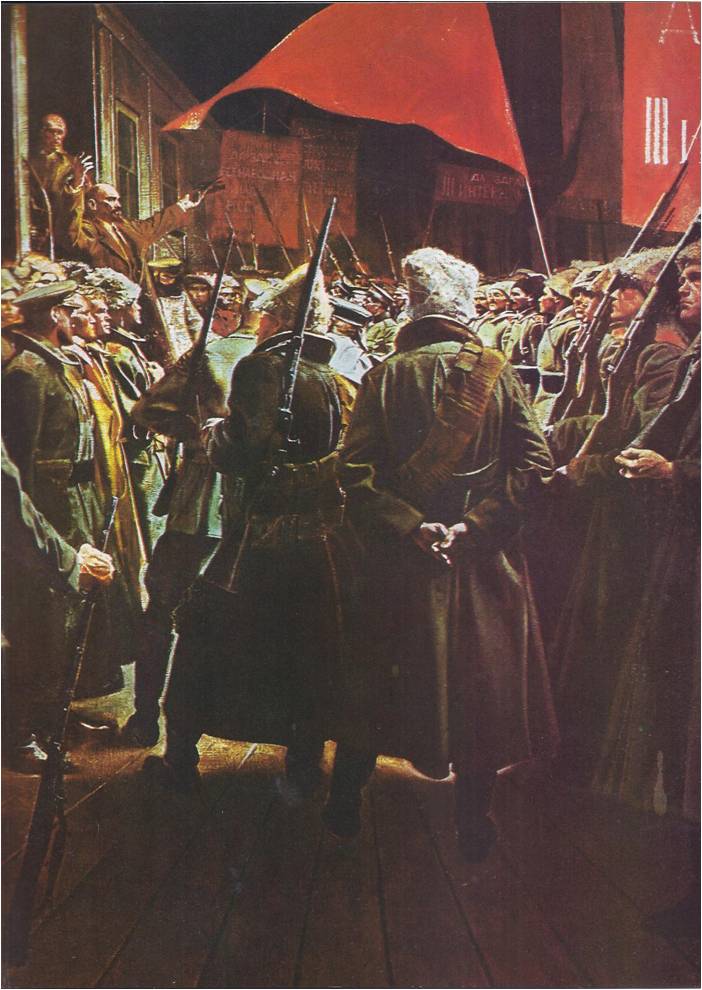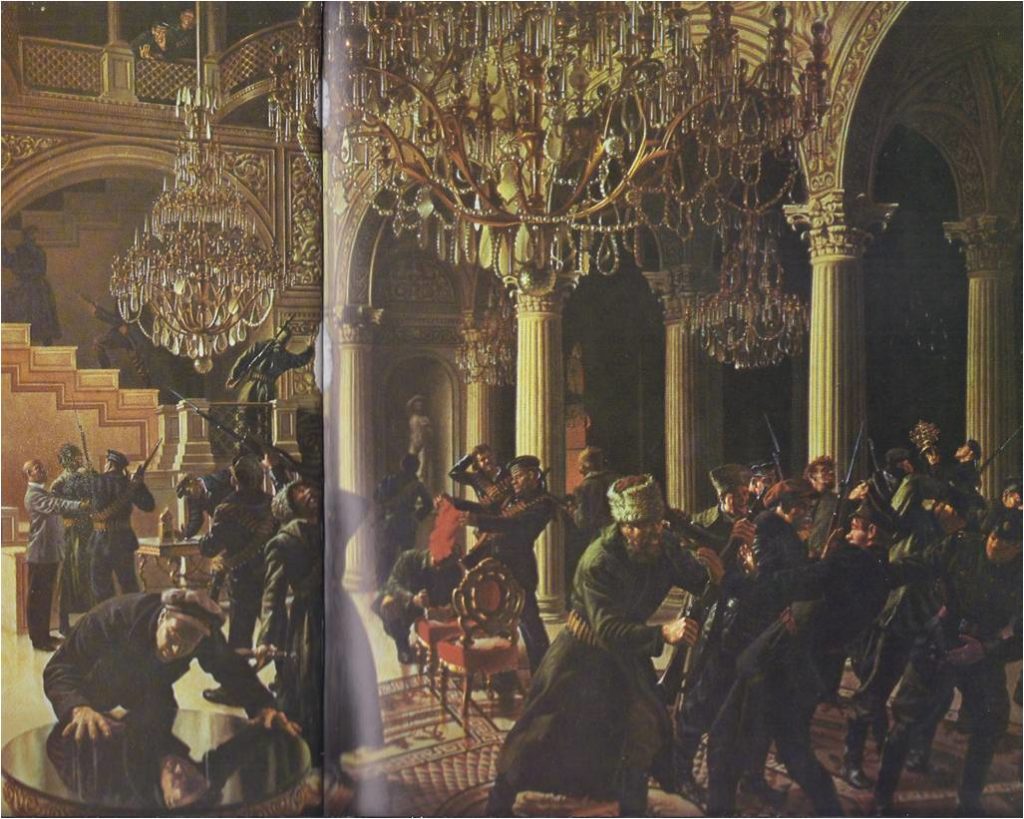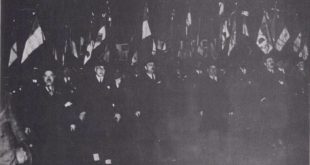LENIN’S REAL name was Vladimir Ilyich Ulianov. Like most Russian revolutionaries, he had taken another name to protect himself from the Police. He looked like anything but a leader of men; someone once said he looked more like a small-town grocer. He was short, stocky, bald and wore a small heard. His clothes were shabby and his pants were usually too long. He was not a great orator but he had a gift for simplifying and explaining complicated questions, which made him an effective speaker before crowds.
Lenin was born in 1870, the son of a schoolteacher who became an official in the school system. The family was fairly well off and no different from thousands of other Russian families. Then Lenin’s older brother, Alexander, went off to study in the Russian capital. Young Alexander became involved in a plot to assassinate the tsar and was hanged with four other students. Lenin was seventeen at the time and he too, became a revolutionist. He studied law, completing a four-year course in one year. He practiced law for a while, but soon became a full-time revolutionist. He was arrested‚ sent to prison for fourteen months and to Siberia for three years. After this, with his wife, Krupskaya, he spent most of his time in exile. They went from one European country to another and were often very poor. Wherever they were, Lenin never stopped studying, writing and working for the revolution. In 1917 he was in Switzerland, impatient to get back to Russia where so much was happening. He was in touch with the Bolsheviks there and sent them instructions, but that was not the same as being on the spot because of the war, however, it seemed impossible for him to travel across Europe.

It was the German government that made his return to Russia possible. The Germans were anxious to stir up a Bolshevik revolution in Russia, in the hope that Russia would then drop out of the war. Lenin and a small group of other revolutionaries were carried in a sealed German train to Petrograd, where they arrived on April 16. A large crowd, carrying banners and accompanied by a band, greeted Lenin at the Finland Station. He addressed the crowd, but, as always, he was not interested in playing the hero. He was interested in one thing and only one thing. He wanted to change the revolution that had already taken place into a revolution of workers and to set up a government based on the teachings of Karl Marx. He immediately began meeting with the Bolshevik leaders and outlining his plans.
They were bold plans and they startled many of the other Bolsheviks. According to Lenin, the provisional government would never establish socialism and must be overthrown. “All power to the soviets!” he said. These councils of workers and soldiers, once they were led by the Bolsheviks, would bring about the revolution. To the people, Lenin offered the slogan of “Peace‚ bread, land.” This was what the people wanted above everything else. The workers won support a revolution that promised an end to death, destruction and hunger; the peasants would support a revolution that promised them land. Once the Russians set up a socialist state, other nations would follow their example and socialism would spread all over the world.
Lenin hammered home his points and the Bolsheviks accepted his policy. So did some of the Mensheviks. One of them was Leon Trotsky, who in May returned to Russia from exile in the United States. Trotsky quickly became one of the leading figures among the Bolsheviks, second only to Lenin. Putting the new policy into action, the Bolsheviks set out to gain control of the soviets and win over the people. They sent agitators to speak to the soldiers at the front and to the workers in the factories. Everywhere they brought their message: “Peace, bread, land! All power to the soviets!” Indeed, it seemed as if this was the message the people had been waiting for. Workers took over factories, peasants took over land from the landowners‚ soldiers set up soviets of their own and thousands deserted from the army.
In July, great crowds, led by the Bolsheviks, poured into the streets of Petrograd in an uprising against the provisional government. Kerensky called in troops who were still loyal to the government and after some fighting, the uprising was put down. Lenin was forced to flee to Finland, while Trotsky and several other Bolshevik leaders were jailed. This set-back proved to be only temporary. The soviets were growing stronger and it was the Bolsheviks they were supporting, not the Mensheviks or the Social Revolutionaries. Trotsky was released from prison and became the head of a military committee. Lenin, disguising himself by shaving off his beard and putting on a wig, slipped back into Russia.
The Bolsheviks tirelessly spread their message: “Peace, bread, land! All power to the soviets!” Workers were armed. Trotsky, a fiery orator, kept winning over the soldiers, including the important garrison at St. Peter and Paul fortress in Petrograd. The soviets had set up their headquarters at the Marinsky Institute, formerly a school for girls of aristocratic families. Here, too, in what had been classrooms and assembly halls, the Bolshevik leaders met. By October, they were again planning an uprising. It was time for them to make their great bid for power.
Except for the actual date of the uprising, there was no real secret about the Bolsheviks’ plans. People came and went continually at the Marinsky Institute. Workers’ and soldiers’ delegations held meetings at which Lenin, Trotsky and other Bolsheviks spoke. Yet Kerensky, who now firmly controlled the provisional government, did nothing to stop what everyone knew was coming.

The reason was that both Kerensky and the provisional government were weak. He had no strong support. As Russia’s military failures continued and its armies became demoralized, the military and landowning groups opposed Kerensky more and more. The various parties in the government could not agree and quarreled among themselves. Even worse, they hesitated to take drastic action against the landowners and distribute land to the peasants. They were doing nothing to get Russia out of the war and not enough to improve the condition of the workers. Furthermore, Kerensky was unwilling to do anything that might be thought to be opposed to freedom, but the Russians had never known real freedom and were not too interested in it now. They wanted peace, bread and land — and were ready to follow the party that promised to give them these things. They turned to the Bolsheviks, who seemed to have a clear, direct program –and so a small group of determined men was able to win the rule of a vast country.
On November 7, those determined men were ready to give the signal for an uprising. Early in the morning, the sound of ride shots rang out in Petrograd and the Bolshevik revolution began. There was some serious fighting, but not much more bloodshed than there had been in the March Revolution. Many residents of the city went about their business as though nothing unusual was happening. Clerks and stenographers looked out of office windows to see men firing rifles in the street and lifeless bodies lying on the cobblestones. In the street, people were going to the theater, the movies and the opera.
The Smolny Institute buzzed and hummed with excitement, for the plans that had been made there were now being carried out. Armed workers arrested the ministers of the provisional government and chased the members of the Duma home. They took over important buildings, like the power plant and the Winter Palace. In Moscow, the Bolsheviks won the Kremlin, then lost it, then won it again. John Reed, an American journalist who was on the scene, called the ten days that began on November 7 “ten days that shook the world.”
At times, during those ten days, it looked as though the Bolsheviks might not succeed. Other political groups were still active and trying to win the people over to their ideas. When the ten days were over, Kerensky had fled the country, the provisional government was no more and the Bolsheviks were in power. As the first snow of winter fell on the land, Russia entered a new age.





